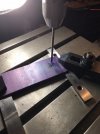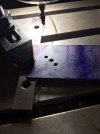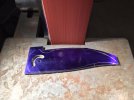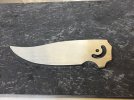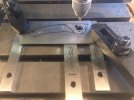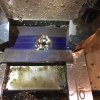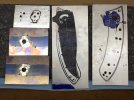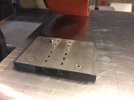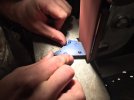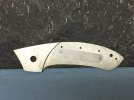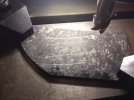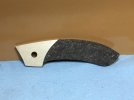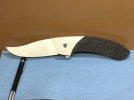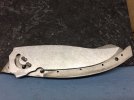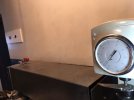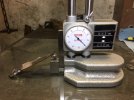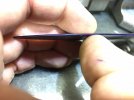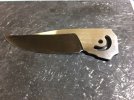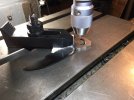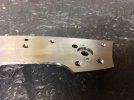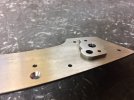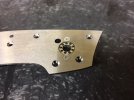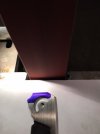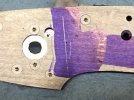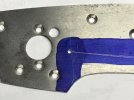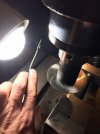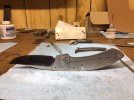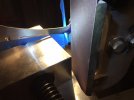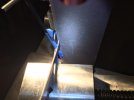- Joined
- Jan 11, 2009
- Messages
- 35
Hi all.
I have been mostly a lurker as of late and have been primarily using the forum as a research tool and knowledge base. I feel as tho I have gotten to a place now where I can give something back and I figured a work in progress thread would be just the thing. A hearty thanks to all of the knowledgeable people who give so freely so that others can learn!
This is my 3rd attempt as a custom folder so feel free to let me know if there is a better way of doing things!
The reason for doing a liner lock is so that I can have most of the screws hidden. I also use the liner to make a bearing pocket and then bolt a hardened plate on on top of that which is then covered up by the bolster. I call it my OCD bearing design . I don't know if it really solves a problem or not but my hope is that for people who are interested in the knife that they will be able to appreciate all the work put into it.
. I don't know if it really solves a problem or not but my hope is that for people who are interested in the knife that they will be able to appreciate all the work put into it.
The top drawing is the initial drawing (by GD Clark) that "we" did to get the flow and concept of the knife fleshed out. You can see the pin holes drawn on it so that we could have a reference point for making a plexiglass model. The knife was drawn on grid paper for 3 reasons. One was that there needed to be a clear horizontal reference. I have wasted way to much time trying to modify a knife that wasn't working and getting stuck because I lost track of where level was. The the other reason was so that I would have a 0.0 reference point to use calipers to measure points for the digital readout on the mill. Lastly, by having a true vertical plane it lets me use a jig for cutting the lockbar, cutting the lockface, and drilling the detent hole's in the liner and the blade.
The plexiglass models purpose is to flesh out how it will feel in the hand and to also make sure the folder will function. Things like detent travel path are really easy to see this way. You can also try several different locations easily by using a felt tip pen. It is also very fast to shape and it doesn't make any dust that you have to worry about breathing.
The last drawing is the final version and has all of the hole locations for the build on it. As you can see it was slimmed down a fair bit. We hadn't planned on it initially but adding a spot to put your index finger ahead of the flipper tab feels really good! It makes it easier for EDC type tasks and when used as a fighter it really made it feel quick. I expect it to be fairly light in hand when it is done as well. The last major difference between the initial drawing and the final drawing was in the shape at the back of the handle. Having it more rounded made for a way better fit for people with bigger hands. GD has small hands and didn't really notice any problems but my pinky came down right on top of the raised part. By rounding it off it also made the back of the knife disappear into the hand better which gives it a really aggressive feel.
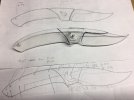
Matt
I have been mostly a lurker as of late and have been primarily using the forum as a research tool and knowledge base. I feel as tho I have gotten to a place now where I can give something back and I figured a work in progress thread would be just the thing. A hearty thanks to all of the knowledgeable people who give so freely so that others can learn!
This is my 3rd attempt as a custom folder so feel free to let me know if there is a better way of doing things!
The reason for doing a liner lock is so that I can have most of the screws hidden. I also use the liner to make a bearing pocket and then bolt a hardened plate on on top of that which is then covered up by the bolster. I call it my OCD bearing design
The top drawing is the initial drawing (by GD Clark) that "we" did to get the flow and concept of the knife fleshed out. You can see the pin holes drawn on it so that we could have a reference point for making a plexiglass model. The knife was drawn on grid paper for 3 reasons. One was that there needed to be a clear horizontal reference. I have wasted way to much time trying to modify a knife that wasn't working and getting stuck because I lost track of where level was. The the other reason was so that I would have a 0.0 reference point to use calipers to measure points for the digital readout on the mill. Lastly, by having a true vertical plane it lets me use a jig for cutting the lockbar, cutting the lockface, and drilling the detent hole's in the liner and the blade.
The plexiglass models purpose is to flesh out how it will feel in the hand and to also make sure the folder will function. Things like detent travel path are really easy to see this way. You can also try several different locations easily by using a felt tip pen. It is also very fast to shape and it doesn't make any dust that you have to worry about breathing.
The last drawing is the final version and has all of the hole locations for the build on it. As you can see it was slimmed down a fair bit. We hadn't planned on it initially but adding a spot to put your index finger ahead of the flipper tab feels really good! It makes it easier for EDC type tasks and when used as a fighter it really made it feel quick. I expect it to be fairly light in hand when it is done as well. The last major difference between the initial drawing and the final drawing was in the shape at the back of the handle. Having it more rounded made for a way better fit for people with bigger hands. GD has small hands and didn't really notice any problems but my pinky came down right on top of the raised part. By rounding it off it also made the back of the knife disappear into the hand better which gives it a really aggressive feel.

Matt
Last edited:


